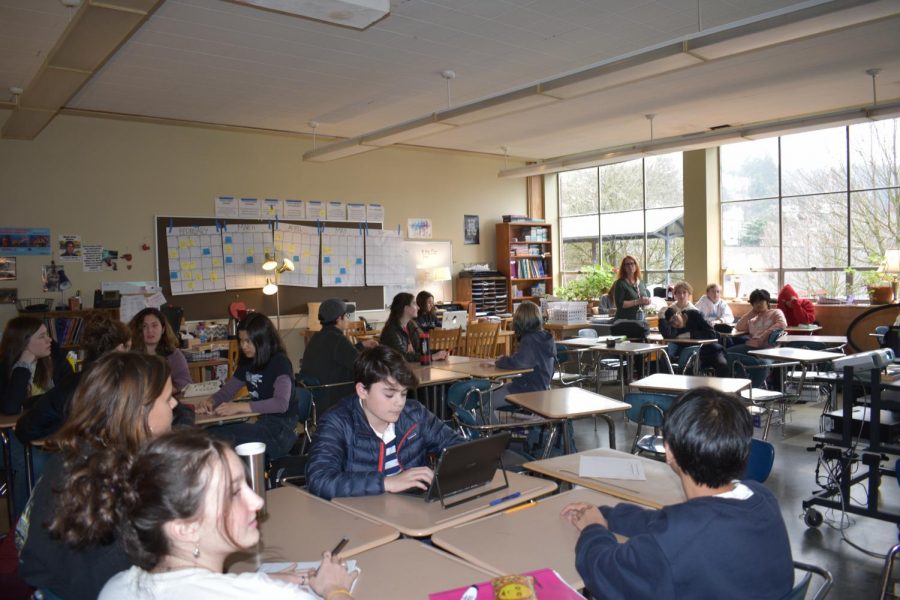Lincoln aims to bring students together through freshman cohorts
Students sit in their FLI class with Ms.Brown. Under the cohort model, freshman share three classes with the same people.
The freshman cohort model was put into place at Lincoln at the beginning of the 2019-2020 school year after Oregon passed Measure 98 in 2016, providing school districts with funding to support increasing graduation rates.
A cohort is defined as “a group of students who work through a curriculum together to achieve the same academic degree together.” In the cohort model, all freshmen share the same three classes with the same group of students. The variations of the cohort model at Lincoln are the AVID class paired with English and U.S. history, freshman leadership and inquiry (FLI) paired with English and U.S. history, and of the FLI classes, there is an option for FLI choir or FLI band.
The freshman cohort model was created to establish a bond between freshmen, which is intended to prevent students from “slipping through the cracks,” according to Lincoln vice principal Jo Ann Wadkins.
“The idea is that we are setting you up with some skills to be connected to the Lincoln community, and to start to see yourself as a successful high school student,” Wadkins adds.
Freshman Tory Schnebly agrees.
“It makes me feel connected with the people in my community, especially since I got pretty lucky with the people in mine,” Schnebly says.
“There’s data to show that students that are on track to graduate in their freshman year are more likely to graduate in four years than students who are not on track to graduate,” according to Wadkins. The cohorts, also called success teams, promote this.
“We are a big school,” says Wadkins. “Sometimes that can be a fear from families that their student isn’t getting the individual attention that a student might need.”
Freshman Alexander Rozas agrees.
“Having the same English teacher and the same FLI teacher is really helpful because English is one of the hardest subjects in school, so you can have more time to talk with your teacher,” Rozas says. “In leadership, it is important that you trust your classmates because you do a lot of spiritual work.”
Additionally to the academic benefits, Rozas also claims there are social benefits to the cohorts. “I probably made a lot more friends than I would have not using the system because it allowed me to spend more time with them,” says Rozas.
Even though the cohorts promote forming bonds and friendships between the students within the cohorts, this can also be a negative thing. “One of the biggest cons is that if you get stuck with someone that you can’t stand, you have three classes with them,” Rozas says.
However, he has an idea to prevent this issue.
“It might be better if we just share two classes, [because], in my opinion, I don’t think it’s one hundred percent necessary to have history involved in the cohort,” says Rozas
Schnebly agrees. “Maybe just make it two classes? It feels a little repetitive,” she says. “I’m limited from so many people I can make connections with.”
Wadkins also agrees that the program can be improved.
“We are still trying to tweak this model so it looks best for our community and our Lincoln students,” says Wadkins. “Just at heart it’s being able to provide nice support for our students, not only in grade nine but think about supporting our students throughout all four years.”
Information from The Community College Journal of Research and Practice agrees with this consensus, but also provides a contrasting point of view. According to their research, it is “indicated that such factors such as dominant group members, lack of commitment to the cohort, failure to meet group expectations, traditional instructional modalities, and inadequate facilities negatively impacted perceptions of the cohort experience.”
Though Wadkins says that there is data to show the cohort model improves increasing graduation rates, data from the Oregon Department of Education contradicts this. In a 2016-2017 study, out of the 50 states of America, Oregon is one out of nine states where the high school cohort graduation rate is seventy percent or less, with the majority of states being in the 80 to 90 percent range. The Oregon cohort graduation rate had been in the 60 percentile in the 2008-2013 school year, and slowly increased into the 70 percentile in the 2013-2014 school year. Yet, the statistics have drastically improved since.
Though the four-year cohort graduation rate in Oregon in the 2017-2018 school year was only an average of 72.59 percent, the 2018-2019 rate was an average of 82.27 percent. The reason for this improvement of nearly ten percent is because of Measure 98. According to Wadkins, every school in PPS has implemented some version of a cohort in the past year, and has been provided funding to support their model.
The cohort model, though it has room for improvement in areas such as the amount of classes students have together, overall, it promotes increasing graduation rates and strengthens the sense of community at Lincoln.

